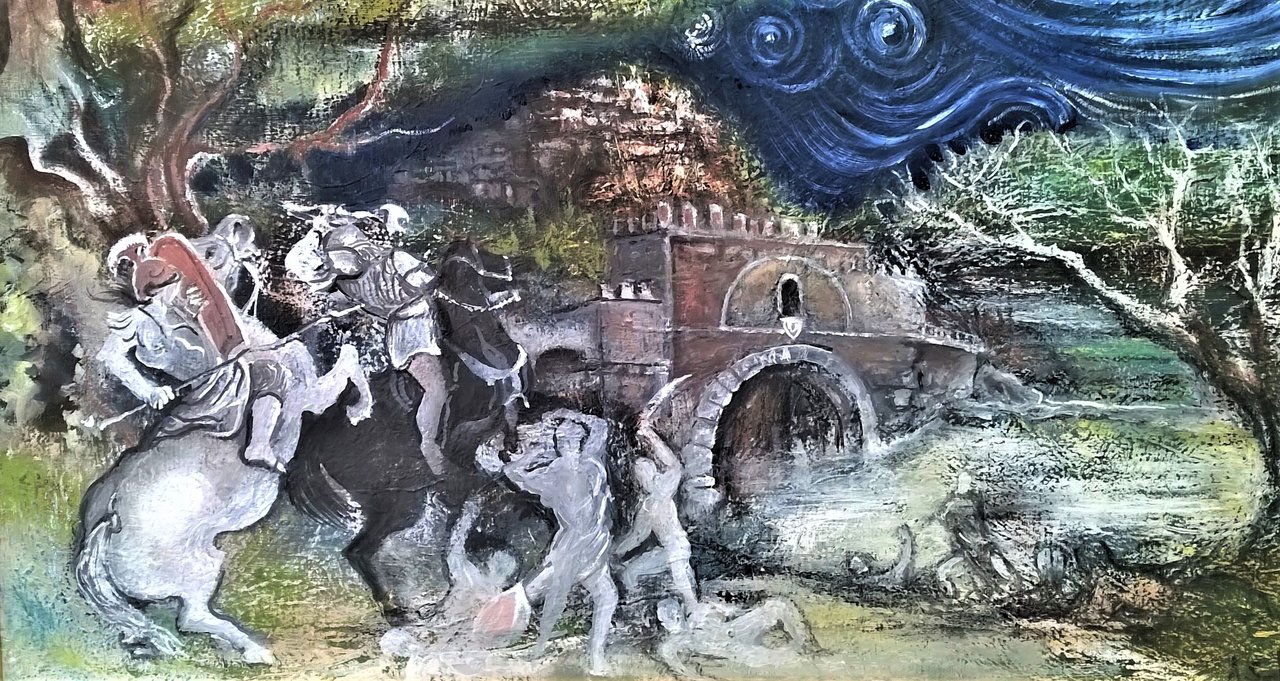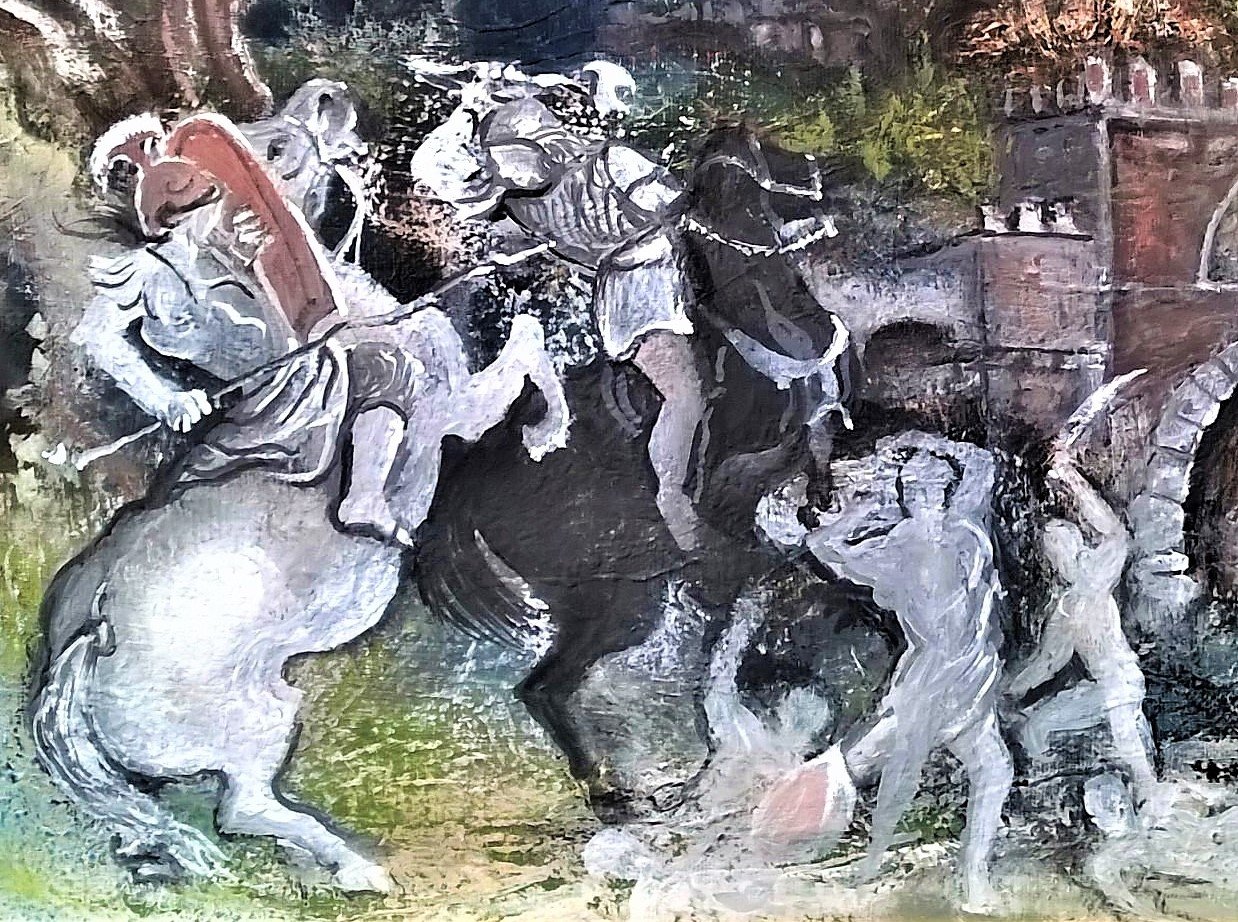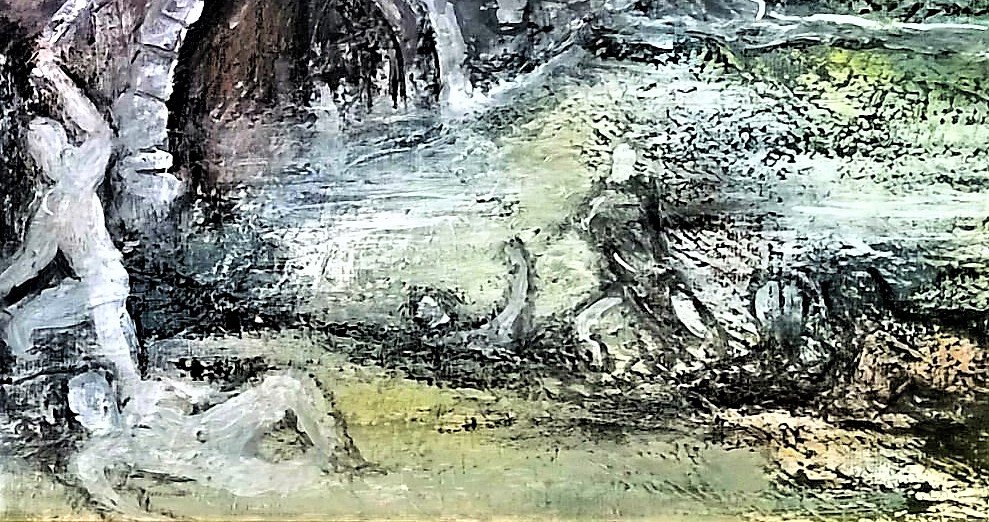
the battle of the ghost knights

2 0 1 8
oil and cement on canvas

Le epoche medievali sono ricche di epiche battaglie tra cavalieri.
Tutti noi abbiamo visto o letto qualcosa a riguardo. Il cinema e la narrativa sono una fonte inesauribile di storie e resoconti di scontri tra opposte fazioni o eserciti, combattute da uomini a piedi o a cavallo, con spade, alabarde, elmi e corazze, con crudeltà, ferocia ma anche con atti di valore, eroismo e sacrifici umani.
Oggi vi presento un quadro ad olio che ho dipinto ispirato da una battaglia molto particolare e misteriosa:
La battaglia dei cavalieri fantasma, del lontano dicembre nel 1517.
Questa storia ha dell'incredibile, degna del miglior libro o film fantasy, ma ha supporto molte autorevoli fonti dell'epoca che l' hanno fatta entrare nella classifica delle battaglie più singolari e misteriose che io conosca.
Il 23 dicembre del 1517, nei pressi di Osio di Sotto in provincia di Bergamo un cavaliere di ventura il conte Bartolomeo III Martinengo scrisse una lettera ad un suo amico ambasciatore di Verona nella quale raccontò che nelle campagne del bergamasco avvenivano delle gigantesche e violente battaglie.
Improvvisamente dai boschi limitrofi uscivano due eserciti che si affrontavano a campo aperto nella pianura, vicino all'oratorio di san Luca.
Il conte, raccontava nella lettera che dapprima i due eserciti si fronteggiavano l'un l'altro, e due nobili cavalieri si incontravano a metà strada cercando un accordo. Il cavaliere più nobile, forse un re, all'improvviso lanciando il suo guanto in aria, dichiarava l'inizio della battaglia.
La lotta tra i due eserciti era tremenda e sanguinosa, con tagli di arti e teste e finiva sempre con la morte di tutti i combattenti.
Il conte, supportato nel racconto da altri nobili illustri, dichiarava nella lettera che sul campo di battaglia non restavano null'altro che le orme dei cavalli e i solchi dei carri.
Questa lettera, è depositata nella Biblioteca Civica Angelo Mai di Bergamo e si trova tradotta in Inglese nella The Huntington Library, San Marino, California, US

detail
Molti altri testimoni asserirono che nei giorni seguenti, e non solo di notte, si vedevano delle ombre di cavalieri senza testa combattere, oppure giganti mostruosi o animali orribili.
Dopo numerose trascrizioni e stampe, la lettera di Bartolomeo giunse fino a Leone X che in un conclave attribuì il fenomeno ad una possibile nuovo tentativo di invasione dei Turchi, provvedendo nel giro di poco tempo a recuperare offerte ed elemosine e fondi per l'imminente crociata.
I fenomeni di avvistamenti dei cavalieri fantasma costituivano comunque un brutto presagio per gli abitanti della Pianura Padana preoccupati di future invasioni nemiche, e così avvenne, con l'ascesa del re Francesco di Francia e il re Carlo I di Spagna, che in pochi anni occuparono l'Italia.
Ma torniamo ai nostri cavalieri fantasma, che verranno descritti anche dal gesuita e missionario francese Alexandre de Rhodes autore di questa lettera contenuta nel The British Library Journal pubblicata dalla British Library e conservata anch'essa nella Biblioteca di Osio.
I misteriosi cavalieri o animali mostruosi continuarono ad essere avvistati per diversi anni, ma esiste una spiegazione a tutto questo?
Sembra di si.
Avvelenamento da Claviceps purpurea un fungo parassita delle graminacee, nome comune è ergot, che in francese significa sperone, e nella segale genera escrescenze a forma di corna, che danno il caratteristico nome di segale cornuta, una pianta affetta da ergotismo.
La claviceps purpurea è la specie che genere effetti allucinogeni perchè contiene degli alcaloidi velenosi e psicoattivi, essi sono dei vasocostrittori che oltre a compromettere la circolazione sanguigna, interagiscono in forma più o meno importante sul sistema nervoso centrale.
In alcuni casi possono essere mortali o generare paralisi importanti.
Quindi i cavalieri fantasma potrebbero essere stati generati da fenomeni di allucinazioni causati dalla segale o altro cereale infetti.
Esiste sempre una spiegazione....o no?
Ah dimenticavo di dirvi che questo funghetto causava anche il Fuoco Sacro, o meglio conosciuto come il Fuoco di San Antonio, e nel medioevo era fonte di epidemie devastanti e di terrore popolare.
Un abbraccio dal cavaliere senza testa.


detail
The medieval epochs are full of epic battles between knights.
We have all seen or read something about it. Cinema and fiction are an inexhaustible source of stories and accounts of clashes between opposing factions or armies, fought by men on foot or by horse, with swords, halberds, helmets and armor, with cruelty, ferocity but also with deeds of valor, heroism and human sacrifices.
Today I present an oil painting that I painted inspired by a very special and mysterious battle:
The battle of the ghost knights, of the far December in 1517.
This story is unbelievable, worthy of the best book or fantasy film, but it has support many authoritative sources of the era that have made it into the list of the most singular and mysterious battles that I know.
On 23 December 1517, near Osio di Sotto, in the province of Bergamo, a knight of fortune, Count Bartolomeo III Martinengo wrote a letter to a friend of his, ambassador of Verona, in which he told of the gigantic and violent battles in the countryside of Bergamo.
Suddenly two armies emerged from the surrounding woods, facing open field in the plain near the oratory of St. Luke.
In the letter the Count recounted that at first the two armies faced each other, and two noble knights met halfway to find an agreement. The noblest knight, perhaps a king, suddenly throwing his glove in the air, declared the beginning of the battle.
The struggle between the two armies was tremendous and bloody, with cuts of limbs and heads and always ended with the death of all the fighters.
The count, supported in the story by other illustrious nobles, declared in the letter that nothing remained on the battlefield except the tracks of the horses and the furrows of the chariots.
This letter is filed in the Angelo Mai Civic Library of Bergamo and is translated into English in The Huntington Library, San Marino, California, US
Many other witnesses asserted that in the following days, and not only at night, we saw the shadows of headless knights fighting, or monstrous giants or horrible animals.
After numerous transcripts and prints, Bartholomew's letter reached Leone Xwho in a conclave attributed the phenomenon to a possible new attempt to invade the Turks, providing in a short time to recover offers and alms and funds for the imminent crusade .
The phenomena of sightings of ghost riders were still a bad omen for the inhabitants of the Po Valley concerned about future enemy invasions, and so it happened with the rise of King Francis of France and King Charles I of Spain, who in a few years occupied the Italy.
But back to our phantom knights, which will also be described by the French Jesuit and missionary Alexandre de Rhodes author of this letter contained in British Library and also conserved in the Library of Osio.

The mysterious knights or monstrous animals continued to be spotted for several years, but is there an explanation for all this?
It seems so.
Claviceps purpurea poisoning a parasitic grass fungus, common name is ergot, which in French means spur, and in the rye generates horn-shaped outgrowths, which give the characteristic name of horned rye, a plant affected by ergotism.
The claviceps purpurea is the species that genus hallucinogenic effects because it contains poisonous and psychoactive alkaloids, they are vasoconstrictors that in addition to compromising the blood circulation, interact in a more or less important form on the central nervous system.
In some cases they can be deadly or generate important paralysis.
So the ghost riders may have been hallucinations caused by rye or other infected cereal.
There is always an explanation .... or not?
Oh I forgot to tell you that this mushroom also caused the Holy Fire, or better known as the Fire of San Antonio, and in the Middle Ages it was the source of devastating epidemics and popular terror.
A hug from the headless knight.



- Art teacher
- Curator of cultural activities
- Artistic director and President of the Cultural Association "I Colori della Vita"

